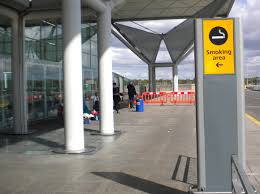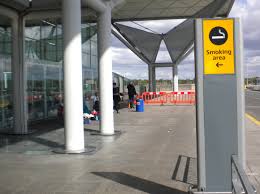
A new report claims that airline passengers and airport workers are exposed to the health risks due to secondhand smoke.
There are smoke-free indoor policies in 23 of the 50 most busy airports in the world. This essentially transforms into the fact that at the world's busiest airports, about 46 percent of the air travelers and employees remain protected from the health hazards posed by exposure to secondhand smoke. designated or ventilated indoor areas are places where smoking is allowed in the other 27 of the busiest airports.
Noting the first assessment of smoke-free policies in the world's airports by the Disease Control and Prevention's, the report was published in Morbidity and Mortality Weekly Report (MMWR). The study includes those airports that see over 2.7 billion passengers annually passing through them.
Those airports that completely do not allow smoking to be done in any part of the indoor area of the air are defined as having a smoke-free policy. Designated smoking rooms, restaurants, bars, or airline clubs are used for smokers in the 27 airports that were defined as having no smoke-free policy.
"The Surgeon General has concluded there is no risk-free level of secondhand smoke exposure," said Corinne Graffunder, director of CDC's Office on Smoking and Health. "Even brief exposure can have health consequences."
In terms of region, the study has found that there are multiple variations in the smoke-free policy status among the airports studied for such polices in 2017. While 18 percent of the busiest airports surveyed in Asia (4 of 22) had a smoke free policy, 44 percent (4 of 9) of the airports had such a policy where as 78 percent (14 of 18) of the busiest airports in North America exercised a smoke-free policy. In Asia, all of the four airports with smoke free policies are in China.
Non-smoking travelers and employees placed at smoke free zones were at the risk of exposure as the secondhand smoke may be transfer to the nonsmoking areas from the designated smoking areas in airports, found an earlier CDC study. Therefore, in such airports, travelers and workers remain at exposure for secondhand smoke.
"Separating smokers from nonsmokers, cleaning the air, and ventilating buildings cannot eliminate exposure of nonsmokers to secondhand smoke," said Brian King, Deputy Director for Research Translation in the Office on Smoking and Health. "People who spend time in, pass by, clean, or work near these rooms are at risk of exposure to secondhand smoke."
In the United States, every year there is an estimated death of about 7,300 people due to lung cancer while about 34,000 people die due to heart related diseases caused by secondhand smoke. Ailments like ling cancer in nonsmoking adults, stroke and coronary heart disease, stroke and even death is caused by people getting exposed to secondhand smoke emitted from burning tobacco products. decreased lung function, respiratory symptoms, exacerbated asthma, middle ear disease, acute respiratory infections, and sudden infant death syndrome can be the ailments for such exposure in children.
(Source:www.prnewswire.com)
There are smoke-free indoor policies in 23 of the 50 most busy airports in the world. This essentially transforms into the fact that at the world's busiest airports, about 46 percent of the air travelers and employees remain protected from the health hazards posed by exposure to secondhand smoke. designated or ventilated indoor areas are places where smoking is allowed in the other 27 of the busiest airports.
Noting the first assessment of smoke-free policies in the world's airports by the Disease Control and Prevention's, the report was published in Morbidity and Mortality Weekly Report (MMWR). The study includes those airports that see over 2.7 billion passengers annually passing through them.
Those airports that completely do not allow smoking to be done in any part of the indoor area of the air are defined as having a smoke-free policy. Designated smoking rooms, restaurants, bars, or airline clubs are used for smokers in the 27 airports that were defined as having no smoke-free policy.
"The Surgeon General has concluded there is no risk-free level of secondhand smoke exposure," said Corinne Graffunder, director of CDC's Office on Smoking and Health. "Even brief exposure can have health consequences."
In terms of region, the study has found that there are multiple variations in the smoke-free policy status among the airports studied for such polices in 2017. While 18 percent of the busiest airports surveyed in Asia (4 of 22) had a smoke free policy, 44 percent (4 of 9) of the airports had such a policy where as 78 percent (14 of 18) of the busiest airports in North America exercised a smoke-free policy. In Asia, all of the four airports with smoke free policies are in China.
Non-smoking travelers and employees placed at smoke free zones were at the risk of exposure as the secondhand smoke may be transfer to the nonsmoking areas from the designated smoking areas in airports, found an earlier CDC study. Therefore, in such airports, travelers and workers remain at exposure for secondhand smoke.
"Separating smokers from nonsmokers, cleaning the air, and ventilating buildings cannot eliminate exposure of nonsmokers to secondhand smoke," said Brian King, Deputy Director for Research Translation in the Office on Smoking and Health. "People who spend time in, pass by, clean, or work near these rooms are at risk of exposure to secondhand smoke."
In the United States, every year there is an estimated death of about 7,300 people due to lung cancer while about 34,000 people die due to heart related diseases caused by secondhand smoke. Ailments like ling cancer in nonsmoking adults, stroke and coronary heart disease, stroke and even death is caused by people getting exposed to secondhand smoke emitted from burning tobacco products. decreased lung function, respiratory symptoms, exacerbated asthma, middle ear disease, acute respiratory infections, and sudden infant death syndrome can be the ailments for such exposure in children.
(Source:www.prnewswire.com)





